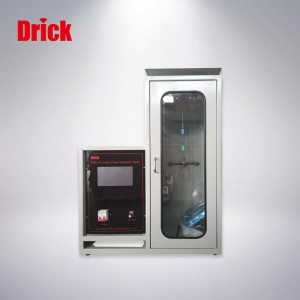DRK-07A Flame Retardant Tester for Protective Clothing
Test items: Determine the tendency of textiles to continue burning, smoldering and carbonization
DRK-07A Flame Retardant Tester for protective clothing, used to determine the tendency of textiles to burn, smoldering and charring. It is suitable for the determination of flame-retardant properties of flame-retardant woven fabrics, knitted fabrics, and coated products.
Product Details:
1. DRK-07A protective clothing flame retardant tester working conditions and main technical indicators
1. Ambient temperature: -10℃~30℃
2. Relative humidity: ≤85%
3. Supply voltage and power: 220V±10% 50HZ, power is less than 100W
4. Touch screen display/control, touch screen related parameters:
a. Size: 7 inches, the effective display size is 15.5cm in length and 8.6cm in width;
b. Resolution: 800*480
c. Communication interface RS232, 3.3V CMOS or TTL, serial port
d. Storage capacity: 1G
e. Use pure hardware FPGA to drive the display, “zero” startup time, and it can run after power-on
f. Adopt M3+FPGA architecture, M3 is responsible for instruction analysis, FPGA focuses on TFT display, speed and reliability are leading similar solutions
g. The main controller adopts low-energy processors and automatically enters energy-saving mode
5. The application flame time of the Bunsen burner can be set arbitrarily, with an accuracy of ±0.1s.
6 Bunsen burner can be tilted in the range of 0-45°
7. Bunsen burner high-voltage automatic ignition, ignition time: arbitrarily set
8. Gas source: Select gas according to the humidity control conditions (see 7.3 of GB5455-2014), condition A selects industrial propane or butane or propane/butane mixed gas; condition B selects methane with a purity of not less than 97%.
9. Approximate weight of the instrument: 40kg
DRK-07A protective clothing flame retardant tester equipment control part introduction
1.Ta——the time of applying the flame (you can directly click the number to enter the keyboard interface to modify the time)
2.T1——Record the time of flame burning in the test
3.T2——Record the time of flameless combustion (ie smoldering) in the test
4. Start-press the Bunsen burner to move to the sample to start the test
5. Stop-the Bunsen burner will return after pressing
6. Gas-press gas to switch on
7. Ignition-press three times to auto-ignite
8. Timing-T1 recording stops after pressing, and T2 recording stops again after pressing
9. Save-save the current test data
10. Position adjustment-used to adjust the position of the Bunsen burner and the style
Sample Humidity Control and Drying
Condition A: The sample is placed under the standard atmospheric conditions stipulated in GB6529 to adjust the humidity, and then the humidity-conditioned sample is placed in a sealed container.
Condition B: Place the sample in an oven at (105±3)°C for (30±2) min, take it out, and place it in a desiccator to cool. The cooling time is not less than 30min.
And the results of condition A and condition B are not comparable.
Sample Preparation
Prepare samples according to the humidity control conditions specified in the above chapters:
Condition A: The size is 300mm*89mm, 5 pieces in the warp (longitudinal) direction and 5 pieces in the weft (transverse) direction, a total of 10 samples.
Condition B: The size is 300mm*89mm, 3 pieces in the warp (longitudinal) direction and 2 pieces in the latitude (horizontal) direction, total
Sampling position: When cutting the sample, the distance from the edge of the cloth is at least 100mm. The two sides of the sample are parallel to the warp (longitudinal) direction and the weft (transverse) direction of the fabric respectively. The surface of the sample should be free of stains and wrinkles. Warp samples cannot be taken from the same warp yarn, and weft samples cannot be taken from the same weft yarn. If the product is tested, seams or decorations can be included in the sample.
Implementation of Standards
ASTMF6413: Standard test method for flame retardancy of textiles (vertical test)
GB/T 13489-2008 “Determination of the Burning Performance of Rubber Coated Fabrics”
ISO 1210-1996 “Determination of the burning characteristics of plastics in vertical specimens in contact with a small ignition source”
Flame-retardant protective clothing*Some flame-retardant clothing
Products categories
-

Phone
-

E-mail
-

Whatsapp
-

Top



